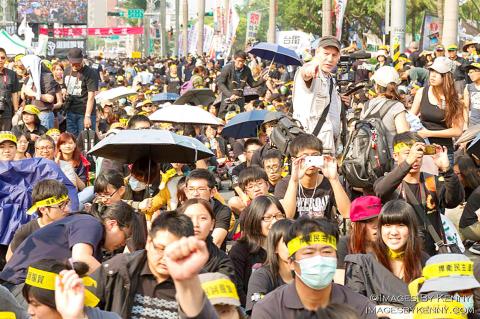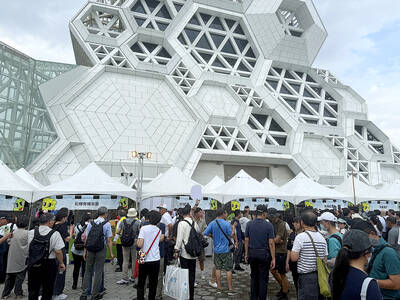When student activists stormed and occupied the Legislative Yuan in March 2014, professional and amateur photographers and videographers flocked to the scene to capture what came to be known as the Sunflower movement. Among these were a small number of expats, some shooting for foreign media outlets, others covering it for personal interest. The occupation lasted for 23 days, with the students leaving voluntarily on April 10, 2014.
“Some of us were on the fringes looking in, some of us occasionally dipped in deeper, and some were right in the middle of it from the start,” says filmmaker Tobie Openshaw, who was shooting for a few news organizations.
Openshaw adds that expats provide a different angle since many were less concerned or aware of the politics involved, instead paying more attention to things like police behavior and the impressive infrastructure put together in a short time to support the protesters such as the food deliveries, charging stations, recycling and so on.

Photo courtesy of Kenny Paul
“For the most part, we were amazed, pleased and moved,” he says, especially compared to how such events turn out in their home countries.
To commemorate the 5th anniversary of the movement, Openshaw has put together a photo exhibition at the Red Room featuring his shots along with work by five other expat photographers and Jiho Chang (張之豪), who actively participated in the occupation. Chang was among the 22 activists sued by the government; the charges were later dropped. Openshaw and Chang will be giving talks at Sunday’s opening, with ample time reserved for questions and discussion.
■ Opening on Sunday from 4pm to 10pm, Red Room (紅坊國際村), 177 Jianguo S Rd Sec 1, Taipei City (台北市建國南路一段177號). Exhibition runs through June 14
■ On the Net: www.facebook.com/events/981591572230753

Water management is one of the most powerful forces shaping modern Taiwan’s landscapes and politics. Many of Taiwan’s township and county boundaries are defined by watersheds. The current course of the mighty Jhuoshuei River (濁水溪) was largely established by Japanese embankment building during the 1918-1923 period. Taoyuan is dotted with ponds constructed by settlers from China during the Qing period. Countless local civic actions have been driven by opposition to water projects. Last week something like 2,600mm of rain fell on southern Taiwan in seven days, peaking at over 2,800mm in Duona (多納) in Kaohsiung’s Maolin District (茂林), according to

Aug. 11 to Aug. 17 Those who never heard of architect Hsiu Tse-lan (修澤蘭) must have seen her work — on the reverse of the NT$100 bill is the Yangmingshan Zhongshan Hall (陽明山中山樓). Then-president Chiang Kai-shek (蔣介石) reportedly hand-picked her for the job and gave her just 13 months to complete it in time for the centennial of Republic of China founder Sun Yat-sen’s birth on Nov. 12, 1966. Another landmark project is Garden City (花園新城) in New Taipei City’s Sindian District (新店) — Taiwan’s first mountainside planned community, which Hsiu initiated in 1968. She was involved in every stage, from selecting

It’s Aug. 8, Father’s Day in Taiwan. I asked a Chinese chatbot a simple question: “How is Father’s Day celebrated in Taiwan and China?” The answer was as ideological as it was unexpected. The AI said Taiwan is “a region” (地區) and “a province of China” (中國的省份). It then adopted the collective pronoun “we” to praise the holiday in the voice of the “Chinese government,” saying Father’s Day aligns with “core socialist values” of the “Chinese nation.” The chatbot was DeepSeek, the fastest growing app ever to reach 100 million users (in seven days!) and one of the world’s most advanced and

The latest edition of the Japan-Taiwan Fruit Festival took place in Kaohsiung on July 26 and 27. During the weekend, the dockside in front of the iconic Music Center was full of food stalls, and a stage welcomed performers. After the French-themed festival earlier in the summer, this is another example of Kaohsiung’s efforts to make the city more international. The event was originally initiated by the Japan-Taiwan Exchange Association in 2022. The goal was “to commemorate [the association’s] 50th anniversary and further strengthen the longstanding friendship between Japan and Taiwan,” says Kaohsiung Director-General of International Affairs Chang Yen-ching (張硯卿). “The first two editions